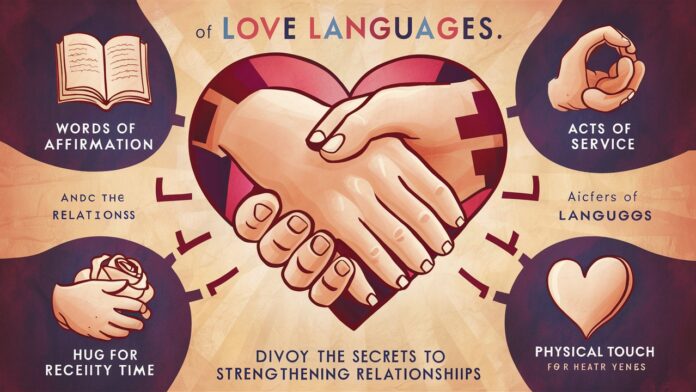Introduction
Love is a universal emotion, but how we express and receive it varies deeply from person to person. Dr. Gary Chapman’s groundbreaking concept, The Five Love Languages, revolutionized how we understand emotional connection. According to Chapman, everyone has a primary “love language”—a preferred way of giving and receiving affection. Misunderstandings in relationships often stem from mismatched love languages, leaving partners feeling unappreciated despite their efforts. This article delves into the five distinct love languages, explaining their nuances and offering insights into how recognizing them can foster deeper bonds. Whether you’re navigating romantic relationships, friendships, or familial ties, understanding these languages can transform the way you connect with others.
1. Words of Affirmation: The Power of Verbal Appreciation
For individuals whose primary love language is Words of Affirmation, verbal expressions hold immense emotional weight. Compliments, encouragement, and heartfelt “I love yous” are not just niceties—they are essential for feeling valued. This love language thrives on positive reinforcement, whether through praise for accomplishments or reassurance during tough times. A simple “You mean the world to me” can uplift their spirits, while harsh criticism or indifference can leave lasting wounds. Partners should prioritize active communication, avoiding sarcasm or neglect. Writing love notes, sending supportive texts, or verbally acknowledging their efforts can make these individuals feel seen and cherished.
2. Quality Time: Creating Meaningful Connections
Quality Time is about undivided attention and shared experiences. For those who prioritize this love language, presence matters more than presents. Distractions like scrolling through phones or multitasking during conversations can make them feel unimportant. Meaningful activities—such as cooking together, taking walks, or having deep conversations—strengthen their sense of connection. Cancellations or postponed plans may be perceived as rejection, so consistency is key. Planning regular date nights or dedicating tech-free hours to bond demonstrates commitment. This language emphasizes how time is spent, not the duration—focused, intentional moments build trust and intimacy.
3. Acts of Service: Expressing Love Through Actions
For some, actions truly speak louder than words. Acts of Service involve doing thoughtful tasks to ease a partner’s burden, like preparing breakfast, running errands, or fixing a leaky faucet. These gestures signal care and reliability. However, broken promises or laziness can breed resentment, as unmet needs may feel like neglect. To nurture this love language, observe what your partner struggles with and offer help proactively. It’s not about grand gestures but consistent, small efforts that say, “I’m here for you.” Reciprocity matters—if both partners value this language, teamwork becomes a foundation of the relationship.

4. Physical Touch: The Language of Affection and Closeness
Physical Touch extends beyond romantic intimacy. Hugs, hand-holding, and casual touches (like a reassuring pat on the back) are vital for those who resonate with this language. Physical presence provides comfort and security, making them feel emotionally anchored. A lack of affection—such as avoiding touch or being physically distant—can lead to feelings of isolation. Partners should prioritize non-sexual touch daily, like cuddling while watching a movie or greeting each other with a warm embrace. In conflicts, a gentle touch during a difficult conversation can bridge emotional gaps.
5. Receiving Gifts: Thoughtful Tokens of Affection
Contrary to misconceptions, Receiving Gifts isn’t about materialism. It’s the symbolism behind the gift—the thoughtfulness, effort, and personalization—that matters. A handwritten letter, a favorite snack, or a souvenir from a meaningful place can convey deep appreciation. Forgetting special occasions or giving generic presents may make these individuals feel overlooked. The key is mindfulness: gifts should reflect their tastes and your understanding of their needs. Even small, frequent tokens (like picking up their favorite coffee) can sustain emotional connection.
Discovering Your Love Language: Strengthening Relationships Through Understanding
Identifying your primary love language—and your partner’s—requires introspection and open dialogue. Dr. Chapman’s official quiz (available online) is a practical starting point. Discuss your results to align your efforts: if your partner values Acts of Service, surprise them by tackling a chore they dislike. If they crave Quality Time, plan a weekend getaway. Remember, love languages can evolve with life stages, so revisit the conversation periodically. Mutual effort to “speak” each other’s language fosters empathy, reduces conflicts, and deepens emotional intimacy.
Conclusion
The Five Love Languages offer a roadmap to more intentional, fulfilling relationships. By recognizing how we and our loved ones prefer to give and receive affection, we can bridge emotional gaps and cultivate lasting connections. Whether through affirming words, dedicated time, selfless actions, affectionate touch, or meaningful gifts, tailoring our expressions of love ensures that our efforts resonate deeply. Love is not one-size-fits-all—it’s a dynamic, evolving dialogue. Embrace these languages as tools to nurture understanding, and watch your relationships flourish.
Frequently Asked Questions (FAQs)
Q1: Can someone have more than one primary love language?
Yes! While most people have a dominant language, many resonate strongly with two. For example, someone might prioritize Quality Time and Physical Touch. Flexibility in addressing multiple languages enriches relationships.
Q2: Do love languages change over time?
Absolutely. Life experiences, aging, or shifts in priorities can influence preferences. Regularly checking in with yourself and your partner ensures you stay attuned to evolving needs.
Q3: How do I handle a mismatch in love languages?
Open communication is crucial. Discuss your needs without judgment, and commit to learning each other’s languages. Small, consistent efforts—like leaving a heartfelt note for a Words of Affirmation partner—build mutual appreciation.
Q4: Do love languages apply to non-romantic relationships?
Yes! They’re relevant in friendships, parent-child dynamics, and workplace interactions. Understanding a friend’s need for Acts of Service or a child’s craving for Quality Time strengthens all bonds.
Q5: Can love languages resolve conflicts?
While not a cure-all, they provide tools to address misunderstandings. For instance, if arguments escalate, a Physical Touch partner might calm down through a hug, while a Words of Affirmation individual may need verbal reassurance.
By embracing the diversity of emotional expression, we unlock the potential for deeper, more harmonious relationships. Start the conversation today—your loved ones will thank you.

